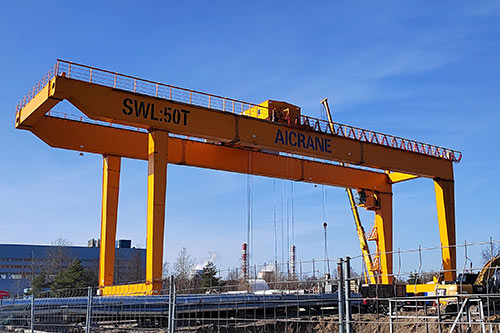


In this article, we’ll break down the key factors involved in calculating the operational costs of a 50-ton gantry crane.
When managing a 50-ton gantry crane, understanding its operational costs is key to ensuring profitability and maintaining efficient operations. These cranes are vital assets in heavy-duty industries such as manufacturing, shipping, and construction, but they come with significant ongoing expenses. In this article, we’ll break down the key factors involved in calculating the operational costs of a 50 ton gantry crane.
The primary operating cost of any gantry crane is energy consumption. Cranes typically run on electricity or diesel, depending on the setup. For electric-powered cranes, the main factor influencing energy costs is the power rating of the motor, along with how often and for how long the crane is in use.
To calculate energy costs:
Find the power rating (in kW) of the crane. For instance, a 50-ton electric gantry crane might have a motor rated at 30 kW.
Estimate the crane’s operating hours per day. If the crane runs for 5 hours a day, this will be your total daily operating time.
Multiply the power consumption by the local electricity rate (usually given in kWh). For example, if the local electricity rate is $0.10 per kWh, and the crane uses 30 kW, the daily cost would be:
30kW×5hours×0.10USD/kWh=15USD/day
This provides a rough estimate of daily energy costs, which can be multiplied by the number of operating days per year for annual energy costs.
Regular maintenance is crucial to ensuring the crane’s smooth operation and prolonging its service life. Maintenance includes routine tasks like lubrication, checking for wear and tear, replacing parts, and performing inspections. On top of that, unexpected repairs due to breakdowns or accidents can add significant costs.
A typical rule of thumb for estimating annual maintenance costs is 2-5% of the crane’s initial cost. For example, if the crane costs $200,000, annual maintenance might range from $4,000 to $10,000.
Maintenance costs will vary depending on:
The age of the crane
The frequency of its usage
The environment in which it operates (e.g., high dust or corrosive environments increase wear)
The cost of labor to operate and manage the gantry crane is another essential factor. Typically, the operator, supervisors, and maintenance technicians are the primary personnel involved in crane operations. Labor costs will depend on:
Operator wages: A skilled operator might earn between $20 and $40 per hour, depending on region and experience.
Work hours: Calculate the total hours worked per day and per year.
For example, if an operator works 8 hours a day at $30 per hour, the daily labor cost is:
8hours×30USD/hour=240USD/day
Multiply this by the number of working days per year to estimate the annual labor cost.
Over time, a crane’s value decreases due to wear and tear. Depreciation is an important cost to consider for long-term budgeting and financial planning. The average lifespan of a gantry crane is typically 20-30 years, but this depends on usage and maintenance.
To calculate annual depreciation:
Determine the initial purchase price of the crane.
Estimate the expected lifespan. A 50-ton gantry crane might depreciate over 20 years.
Subtract the expected residual value (if applicable), which is typically around 10-20% of the initial cost at the end of its life.
For example, if a 50-ton gantry crane costs $200,000 and has a residual value of $40,000 after 20 years:
(200,000−40,000)/20 years=8,000 USD/year
Thus, the annual depreciation would be $8,000.
Insurance is crucial to protect the crane against potential accidents, damage, and theft. The cost of insurance varies based on factors such as the crane’s value, usage, and location.
On average, crane insurance can range from 1-3% of the crane’s value annually. For a crane worth $200,000, this could be between $2,000 and $6,000 per year.
Other operational costs may include:
Taxes and fees: Local taxes on equipment or special operational permits.
Fuel costs: If the crane runs on diesel, fuel costs will need to be factored in.
Parking and storage: Fees for storing the crane when not in use.
The operational costs of a 50-ton gantry crane are a combination of energy usage, maintenance, labor, depreciation, insurance, and miscellaneous costs. By understanding and tracking these expenses, businesses can make more informed decisions about crane operations, maintenance schedules, and budgeting. Regular monitoring of these gantry crane costs helps optimize crane efficiency and reduce overall operational expenses, ultimately contributing to a more profitable operation.
